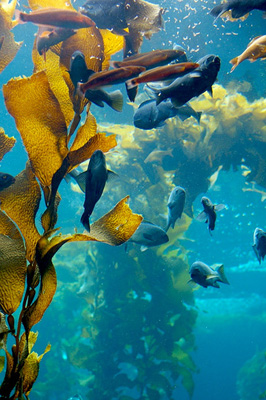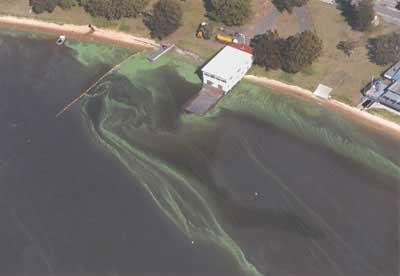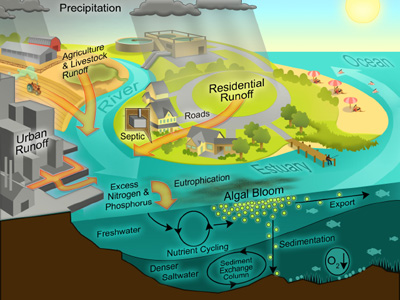3. Eutrophication & Health (1/5)
Eutrophication
In nature, eutrophication is a common phenomenon in freshwater ecosystems and saltwater estuaries and is really a part of the normal aging process of many lakes and ponds. While this is different for each lake or pond or estuary, those that are naturally fed with rich nutrients from a stream or river or some other natural source are described as "eutrophic," meaning they are nutrient-rich and therefore abundant in plant and animal life. Eutrophication is not necessarily harmful or bad, and the word itself is often translated from the Greek as meaning "well nourished" or "good food." However, eutrophication can be speeded up artificially, and then the lake or coastal zone and its inhabitants eventually suffer as the input of nutrients increases far beyond what the natural capacity of the area should be.

Source: Friends Revolution
The role of humans in eutrophication
Human activities have in the past decades (starting in the mid 20th century) led to a dramatic increase in the amount of nitrogen (N) and phosphorous (P) in many aquatic systems.
Human sources of N and P
- Fertilizer used in agriculture, golf courses and gardens
- Nitrogen expelled by the burning of fossil fuels
- Runoff due to soil erosion
- Discharge from sewage treatment plants
Impacts in coastal ecosystems
Although plants need nutrients to survive a too high level of nutrients in the water can cause all kinds of problems. A too large increase in nutrients leads to a complex set of biological and chemical responses which can seriously threaten water quality and thus biodiversity. It can also cause problems for human health. The different processes and effects of coastal eutrophication are well documented and it has been considered as one of the biggest threats to marine ecosystem health. Primary production is usually limited by availability of light and nutrients. Nutrient enrichment increases phytoplankton primary production, which increases biomass. This might even lead to algal blooms, which in turn decreases light penetration through the water column.

Source: ANRA
Effects of euthrophication
Major effects of eutrophication include changes in structure and function of the entire marine ecosystem and reduced stability of the system. Increased nutrient input leads to the following direct chemical responses:
- A corresponding increase in nutrient concentrations in the water column
- Change in ratio between dissolved inorganic nitrogen (DIN) and dissolved inorganic phosphorus (DIP) in the water:
What is the DIN:DIP ratio?
Responses to nutrient enrichment (pelagic ecosystems) involve a gradual change towards:
- Increased planktonic primary production compared to benthic production
- Dominance of microbial food webs over linear planktonic food chains
- Dominance of non-siliceous phytoplankton species over diatom species
- Dominance of gelatinous zooplankton (jellyfish) over crustacean zooplankton
Finally, eutrophication issues are often divided into three groups:
- Causative factors: inputs, elevated nutrient concentrations, Redfield ratio changes
- Direct effects: primary producers, namely phytoplankton and submerged aquatic vegetation
- Indirect effects (secondary effects): related to zooplankton, fish and invertebrate benthic fauna (animals living on the seafloor).
You can learn more about eutrophication and harmful algae in the tutorial on Marine Pollution.

